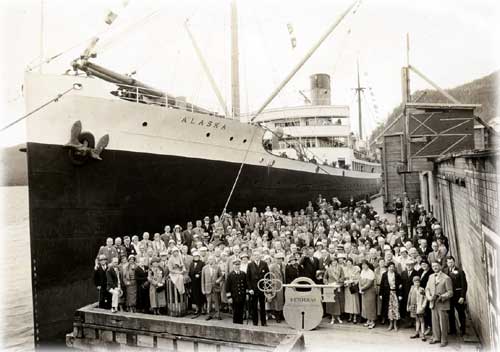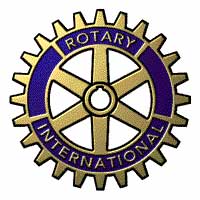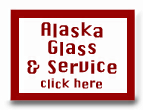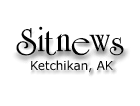 Ketchikan's 'Rotary Wheel' Still Turning Hardworking club celebrates a century By June Allen February 23, 2005
With such a large membership, almost everybody is acquainted with a Rotary club member. And almost everyone is familiar with Rotary's cogged wheel logo, a symbol of the hard-working club. But not everyone knows what Rotary clubs are all about. That was summed up in Rotary President Mike Harpold's address at the centennial party: "(What Rotary is) is the spirit of community service," he said, "doing something good for the betterment of everybody!"  Photographer: Elliot L. Fisher Photograph Courtesy Tongass Historical Society 76.7.9.2
It was just one hundred years ago that the first Rotary club was founded in the bustling big city of Chicago by a group of business and professional men who wanted to foster among themselves, in 1905, "the same friendly spirit they had felt in the small towns of their youth." They met at the invitation of Rotary's founder, attorney Paul P. Harris, in late February 1905. The Chicago organizers decided to name their club "Rotary," after the fact that they met in each other's offices a rotation practice that was discontinued early on because the new club grew by leaps and bounds until much larger quarters were needed for meetings. But the Rotary name remained, as did the distinctive rotary wheel logo, which signifies the ever-turning, hard-working spirit of Rotary. The logo started out as a wagon wheel in 1905 but soon grew into the present and more modern cogged wheel, which represents "a well oiled, efficient machine working for service to mankind." The early-century Rotary founders' original mission was simply to expand the professional and social interests of its members. But as membership spread across Chicago and then across the country, its mission became one of service to the community, thus its motto "Service Above Self." So effective were the Rotary practices and dedication to those goals that by 1921, just sixteen years after that first Chicago club was formed, Rotary had matured into a network of hundreds of clubs not only across America but on six continents as well, so in1922 the name Rotary International was adopted. In 1925, in the far-off Territory of Alaska, Harry C. Nunan, the manager of the Ketchikan branch of New England Fish Co.(NEFCO), launched the idea of forming a Ketchikan Rotary club after he had visited Rotary clubs in Seattle and Vancouver, B.C. It was not that the little town on Tongass Narrows lacked for social and fraternal organizations. There were many! But the community also had many needs, some not being met. Ketchikan in 1925 was a bustling and prosperous port city that billed itself as the salmon-canning capital of the world! Booming prosperity generally comes with a darker side, and in rowdy Ketchikan's case, that was true. There was plenty of opportunity for community service! An organizational meeting to form the Ketchikan Rotary Club was held March 31, 1925, when officers and directors were elected. Members came largely from the business community. Ketchikan Rotary would become the first Rotary Club in all of Alaska, the 2000th club under the Rotary wheel logo - and thus the name Rotary 2000. The new club laid claim to being the first service club in Ketchikan.  Donor: Doris Tobin Brodine Photograph Courtesy Ketchikan Museums 99.2.9.6
Members would meet on Tuesday afternoons and, unlike most clubs, attendance was mandatory! Ketchikan's Commercial Club, a strong business organization and the forerunner of today's Chamber of Commerce, was at first upset, fearing those mandatory meetings would hurt attendance at their own meetings. The fear proved unfounded. The charter ceremonies of Ketchikan's Rotary 2000 were held in the spacious meeting room at the rear of the Blue Fox Café. The historic Blue Fox was down just a couple of doors from the concrete Tongass Trading building on Front Street. It was, like many Ketchikan businesses, a deep but narrow building with a café counter down the left side, booths on the right and a narrow hallway midway that led to the Ingersoll Hotel lobby. In the rear was a spacious meeting room that opened onto the alley that bisects the block between Front and Main Streets. The charter meeting date was May 25, 1925, with many visitors attending. An etched ivory gavel was presented to the new club by Rotarian Frank Parrish of Seattle. Prince Rupert in those days was almost a sister city to Ketchikan baseball rivals and always Fourth of July visitors -- and a number of the Canadian Rotarians had arrived for the ceremony. A special guest, Rotary District Governor Frank C. Riggs of Portland, Oregon, arrived to present the charter to the new Alaska club. In addition to the officers and directors of Rotary 2000 elected earlier, the other charter members were Gerry H. Bach of the Admiral Line; J.C. Barber, head of Citizens Power & Light and Ketchikan Cold Storage; John R. Beegle, the town's first Customs officer and then owner of Beegle Packing Co.; Frank Bold, laundry owner; Willis Bryant, with the Heckman Co.; Eldon J. Daly, manager of Ketchikan Spruce Mills, and Van H. Fisk, later a Petersburg mayor. Also E.C. Howard, who owned a fur store; Alfred Howe of Tongass Trading; L.H. Kubley of Kubley's candy store as well as the fire chief; I. G. (Gus) Pruell, jeweler; K.L. Steberg, manager of the oil dock; William L. Schlothan, Northern Machine; William K. Spaulding, insurance man; H.C. Strong, Citizens Utilities and Ketchikan Cold Storage, and Norman "Doc" Walker, pharmacist. The newly chartered members looked around with new eyes and saw many projects waiting for their attention. The club's first and continuing project interests were with the youth of Ketchikan. From Ketchikan's earliest days the lack of a swimming hole for these sea-side youngsters had concerned Ketchikan. They would play and possibly one day work on the water and none of them knew how to swim! So shortly after the club was chartered, it took on that challenging community project. A considerable sum of money was raised for the purpose of putting a dam in Schoenbar (Ketchikan) Creek at the ballpark, the records show. But this wooden dam was undermined by the force of the water and proved to be a disappointing failure. Undaunted, Rotary tried again. In 1930 each member had individually raised and donated $1,800, and the club managed to raise even more funds through the sales of shares for purchasing a special piece of pioneer miner Martin Bugge's beach property just south of town. It would eventually be called Rotary Beach or Rotary Park. The beach along Bugge's gold claim was the ideal spot for a pool and picnic area. Just offshore from a high-tide pool stood the supports of the abandoned George Inlet Cannery fish trap, with cross beams from which experienced adult swimmers would jump or dive into the water. Parents were pleased when the trap base finally washed out in a winter storm! The Rotary plan was to build a concrete dam at the natural enclosure between two rock promontories which would form a swimming pool that wouldn't flow out with the tide. As work progressed, the entire beachfront was cleaned, picnic benches put in place, outhouses built and parking areas cleared. Across the highway -- a gravel road that had been built between Ketchikan and Saxman just five years earlier -- the volunteers dammed a small stream tumbling down the hillside in order to pipe water to the park for washing up sandy legs and bottoms, and eventually putting in flush toilets.
Rotary's enthusiasm pulled the whole community into their immense effort to build that pool and picnic area. Every lodge and organization in town pitched in with dollars and time! School children licked their pencils and chose names for the popular beach front park. Little Bobbie Race and Marjorie Voss both won prizes for choosing names. But the wonderful swimming-pool park was just one of the first and one of many, many Rotary projects. They included recognizing others for outstanding community service. In its early years Rotary presented Harold Foss with a gold medal for saving the life of Stanley Oaksmith Jr. It presented Miss Yvonne Aikens with a gold watch for saving young Denny O'Connor from drowning. Rotary 2000 held annual meetings at the beginning of each school year, welcoming teachers and to recognize the importance of education to Ketchikan's youth. The club for many years hosted an annual Christmas party, and even today smiling Rotary members still donate Christmas baskets and toys to families in need and can be seen smiling in the wind and cold rain near the entrances to stores, ringing Salvation Army bells! Rotary's motto of "Service Above Self" continues to be practiced rather than preached. In 1987 several Rotary 2000 members decided interest in Rotary activities in Ketchikan had grown enough to merit the formation of a "breakfast club" - and First City Rotary was born. Times continued to change, and in 1991 Rotary's men-only policy was abandoned and women were welcomed to become members of Rotary. Both of today's Ketchikan Rotary clubs participate in a much larger world than did the founding members. Service projects include providing college scholarships, participating in a foreign students exchange program, contributing to health care for children, and organizing and assisting an orphanage in the Russian far east, Alaska's northern near neighbors. But of all the Rotary 2000 and First City Rotary projects, perhaps one of the most unique and appreciated is Rotary House, two condos that the club purchased in the Mary Frances Apartments, outfitted, furnished and maintains so that out-of-town neighbors have a place to stay, at a nominal rate, when loved ones are patients at Ketchikan General Hospital. So that's a brief outline of Ketchikan's Rotary story of continuing service to the community as this year's 80th anniversary slips into the past. Rotary Park's swimming pool at Bugge Beach remains a big attraction these 75 years after it was created and someone recently snapped a picture of a surfer just beyond the swimming pool! Times do change. Few of us will recognize the names of the founding members of 1925. And only a few will recognize many of the faces in the more recent photograph of the 1955 Rotary club. But we pass today's Rotary club members on the street every day! Do you know who they are? They'll be wearing lapel pins, that little hardworking cogged wheel pin. Tell them "Thank you."
june@sitnews.org
All rights reserved. Not to be reprinted in any form without the written permission of June Allen.
|






